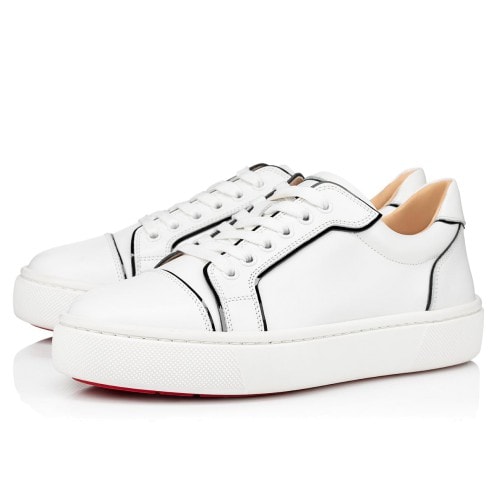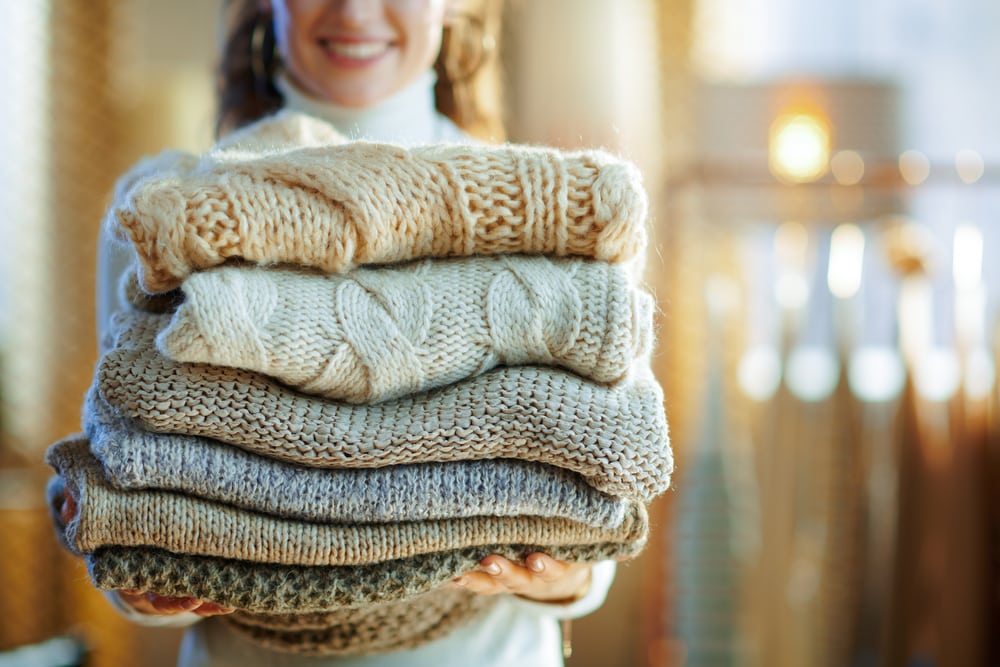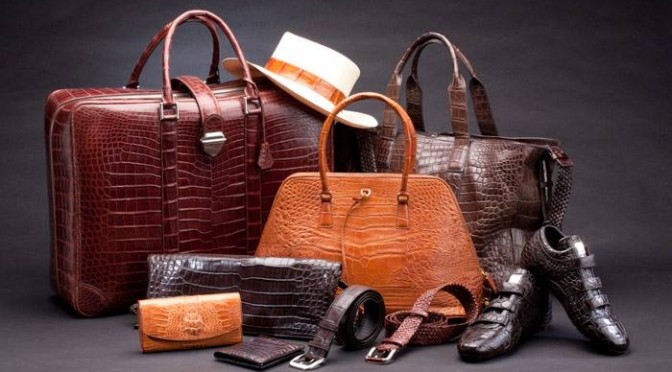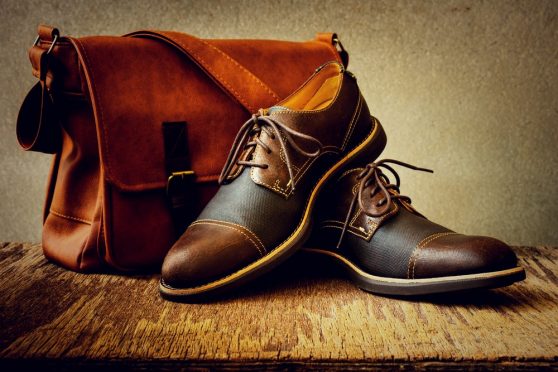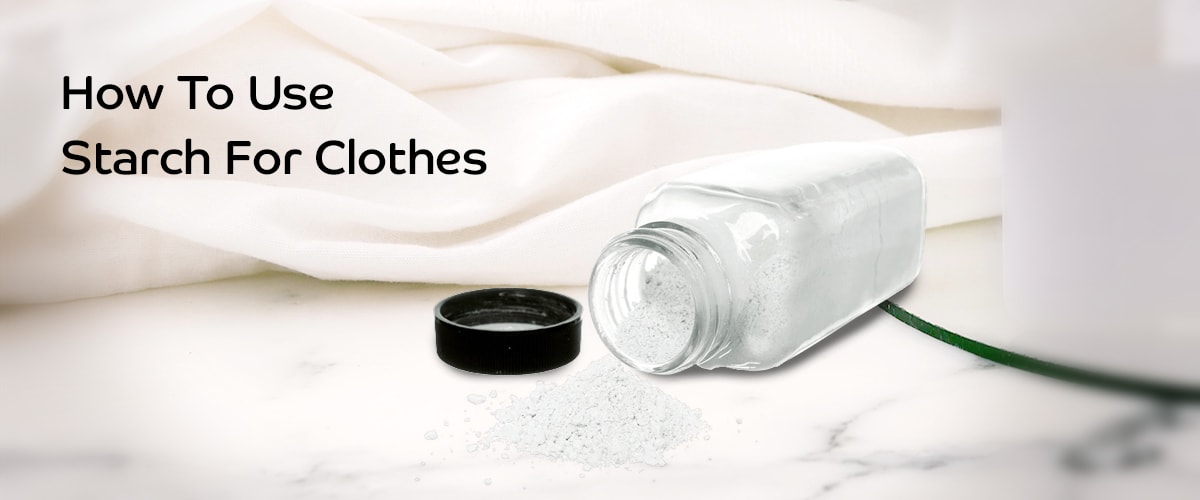
Table of Contents
Starching is a basic method that keeps your cotton sarees, kurtas, dhotis, and even bed linens in their best state. Clothes made up to 100% cotton, cotton blends and linen lose needs starch to look and feel crisp.
Despite being a crucial ingredient to a good wardrobe, many people don’t know how to use starch for clothes. If you are on the same page, don’t worry, this article will tell you everything about starching clothes at home.
THINGS YOU SHOULD KNOW
People often get confused between starch and laundry sizing. They both are different from each other. Starch is used to stiffen clothes, whereas laundry sizing gives a bit of structure or body to the fabric. It is lightly sprayed on some areas of garments during ironing where a structure is required. It works well on synthetic fibres whereas starch is used on cotton clothes only.
But why exactly do you need starch for clothes? Let’s, see:
What Does Starch Do To Clothes
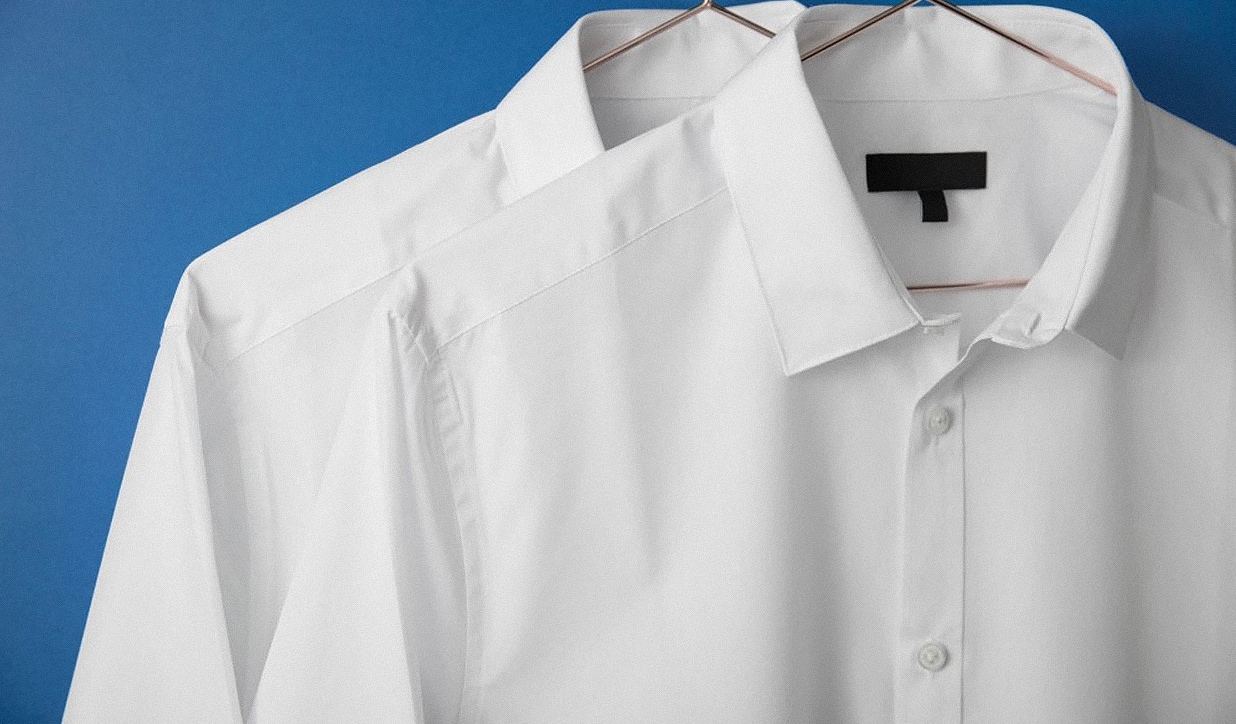
You can use starch for clothes to make them crisp and wrinkle-free.
- It also makes cleaning easier as dirt & sweat get stuck to the starch instead of the fabric.
- It helps in ironing cotton and cotton blends easily.
- Starching also prevents wrinkles to a great length.
- It helps in lesser wash cycles are a starched garment can be worn more times.
What you should know
- Starch will give better results on natural fibres like pure cotton or linen as they hold it better in comparison to fabrics that carry a blend of natural and synthetic fibres like a cotton-poly blend.
- You should use starch for clothes that are made of woven fabric as it will not work well on knit fabrics.
When to use starch for clothes
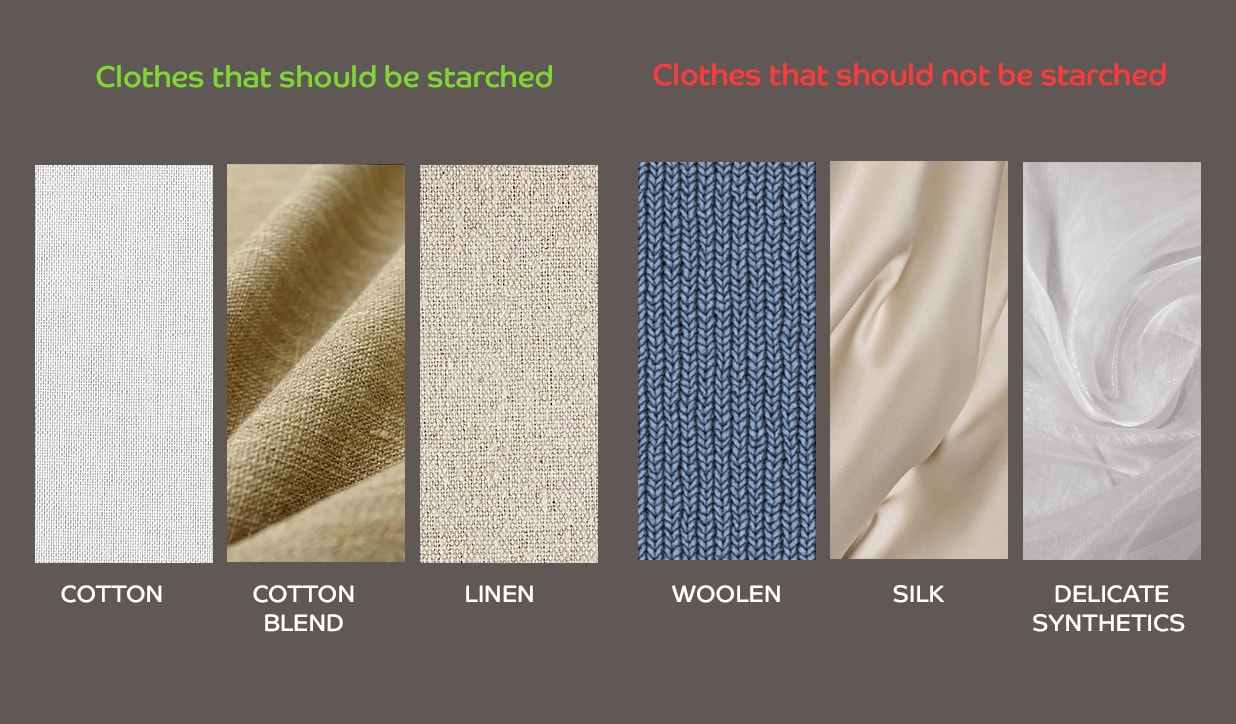
It is not ideal to overuse starch as it will make the threads of the fabric deteriorate or fray. In case of clothes like kurtas or shirts, the cuffs and collars will get affected badly with frequent starching. So, you should do starching only if you have to wear the garment. It is not ideal to use starch for clothes after washing if you are going to store them for a longer period. Once you put starch, try to wear the garment multiple times. And soak and wash the garment properly to remove layers of starch before you starch a garment again.
What Not to Starch
You should not use starch for clothes that don’t have to look stiff. Then, there are some delicate fabrics that may not tolerate starch. Here are some fabrics that you must never starch:
- Wool
- Wool-blends
- Cashmere
- Silk
- Silk-blends
- Delicate synthetics
You can either buy starch for clothes or make it at home as well. We will start with store-bought starch first.
How To Use Store-bought Starch For Clothes
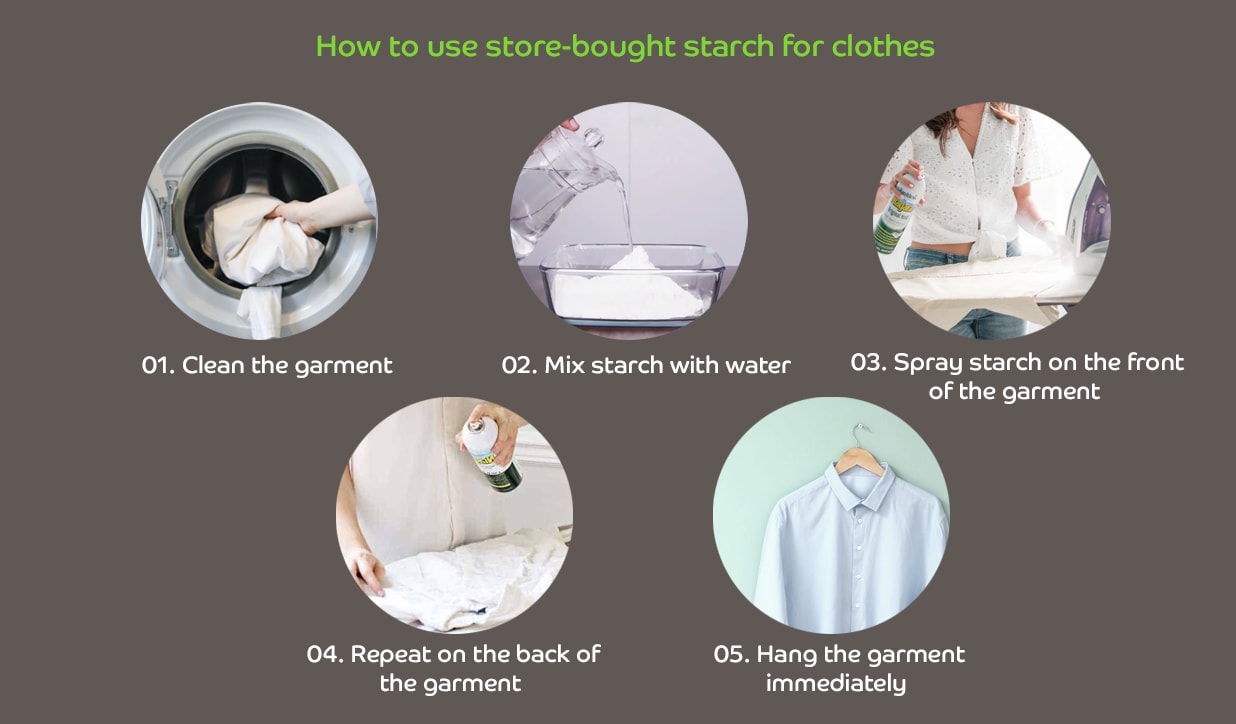
You can buy starch from the store rather than making your own mixture. Most grocery stores will have starch in the laundry aisle. You can purchase it in liquid or powder form. A few good brands of starches are Revive, Dr Beckmann, and Easy on Double Starch.
Clean the garment
Prepare the garment by unbuttoning any buttons on the garment, including the sleeve and collar buttons. Remove stains before washing by working a little detergent into them with a cloth, or by using a stain remover pen. You can also refer to our guide on stain removal. Then, wash it on the delicate or normal cycle, depending on the instructions, amount of stains, and durability of the fabric. Next, put the garment on a hanger to air dry. Avoid putting the garment into the dryer unless necessary. If you do put it in the dryer, use a low heat setting.
Mix starch with water
You will need to mix starch with water before use. Take four tablespoons of starch and add it to one pint of hot water in a bowl or jug. Stir until the mixture resembles milk. Then, pour the mixture into a spray bottle for use. You can use the amount of water and starch recommended above, but you should check the directions on the starch label before creating the mixture.
Spray the starch on the front of the garment
Lay the garment on the board and apply starch on the front of the garment. Apply the starch in a light and even coat across the expanse of the garment. Wait a couple of seconds to allow the product to seep into the material of the garment. Then, press lightly using an iron set to the recommended heat level for the material. If a heat level is not recommended, use a high heat setting so that you will cook the starch.
Repeat on the back of the garment
Turn the garment so that the back of the garment is facing up on the ironing board, and then apply an even coating of starch. Iron carefully the back of the garment. If you are starching garments like a shirt, kurta aur suit, trousers or pyjama, continue the process by starching and ironing each arm/leg finishing the job with an application of the starch to the collar.
Hang the garment immediately
Place the garment on a garment hanger, and allow the garment to be exposed to fresh air for a couple of moments before placing it in a closet. This will provide time for the starch to blend adhering to the fibres of the garment and provide a superior hold, creating the crisp texture and look that you want.
This was all about using store-bought starch for clothes. Now, let’s move to see how to make and use homemade starch.
How To Use Homemade Starch For Clothes
In order to get the best results, wash and thoroughly dry the garment before attempting to apply any type of starch to the garment. Washing removes any dirt or grime that could interfere with the stiffening properties of the starch, as well as inhibit the ability of the product to protect the fibers in the weave of the garment.
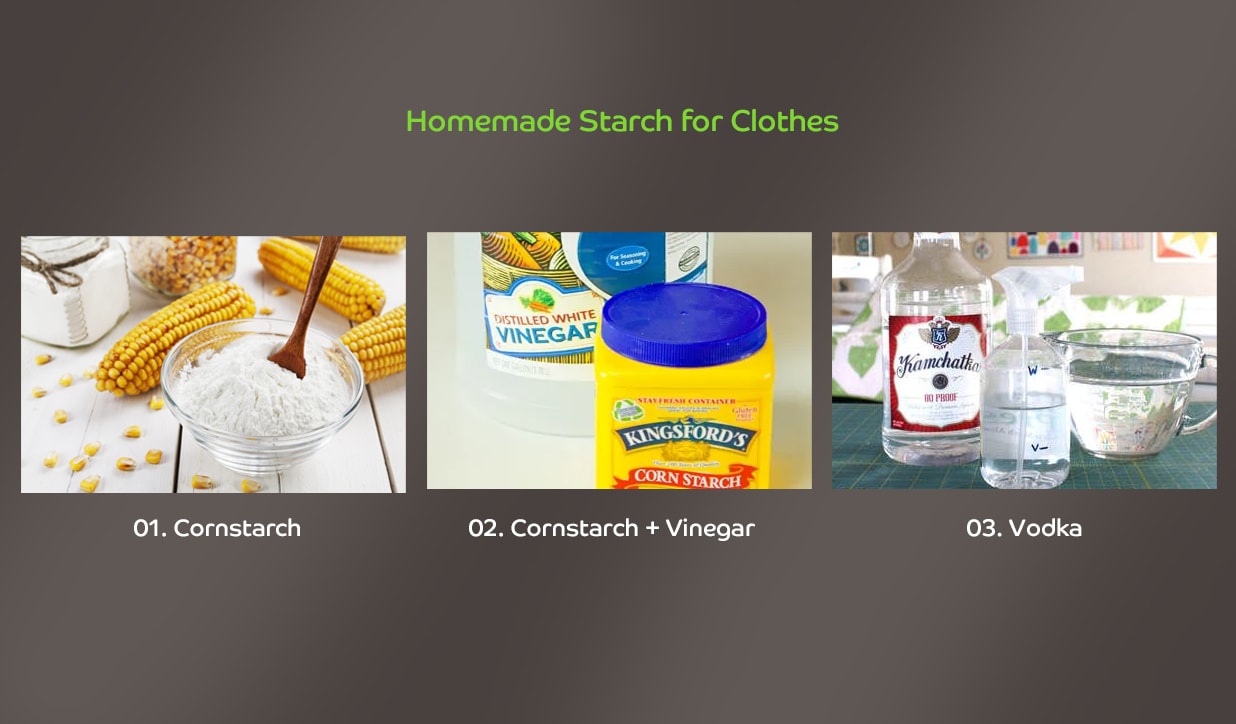
Using cornstarch for clothes
Mix cornstarch with water
You can make your own starch mixture out of cornstarch and water. Mix 1 ½ tablespoons of cornstarch with 2 cups of water. Stir it until it looks milky. Pour the mixture into a bucket or into the sink. Add warm water until the sink or bucket is nearly filled. You should have enough water in the bowl or sink so that the garment can move freely. Not enough water can result in a stiff garment. Use distilled water if you have hard tap water. If not, tap water should be fine to use.
Soak the garment into the water
If the garment is coloured, turn it inside out. Then, immerse the garment into the water. Work it through and then squeeze out the excess water. You should only immerse one garment into the water at a time.
Put the garment into the washing machine
You can also choose to starch the garment in the washing machine rather than soaking it with your own hands. Allow the garment to run through one regular wash cycle and then pause it as it reaches the final rinse through the drum. Then, pour the mixture into the fabric softener dispenser, or directly into the flow of water. Do not pour the mixture in and allow it to sit in the dispenser throughout the entire washing cycle, or it may cause clogging.
Hang the garment to dry
Put the garment on a hanger and allow it to dry until it is damp. Once it is damp, remove it from the hanger. Iron it while it is still slightly damp. This will make the garment crisp and wrinkle-free. Make sure not to use too high of a heat setting if your garment is made of a delicate fabric.
You can use a mixture of cornstarch and vinegar in the same manner.
How to prepare starch using Cornstarch & Vinegar
Add cornstarch to hot water
Pour 2 cups (473 ml) of water into a small saucepan, and place it on the stove. Turn the heat to medium-high, and allow the water to heat. You can use distilled or tap water for the spray.
As the water is heating, add 1 tablespoon (8 g) of cornstarch to the pan. Use a whisk to mix it into the water, and allow the mixture to come a boil, which should take 5 to 7 minutes. Remove the pan from the heat. By heating the mixture, you allow the cornstarch to melt into the water so you don’t have to worry about it separating as much.
Add vinegar to the mixture
After you’ve taken the pan off the heat, add 1 teaspoon (5 ml) of vinegar to the pan. Use the whisk to fully incorporate it into the cornstarch mixture. Vinegar naturally disinfects clothing, which is ideal if you’re using the starch spray between washes.
Store in a spray bottle
When the spray is completely mixed, carefully pour it into a spray bottle. For best results, keep your homemade starch spray in a cool, dark spot. The spray should keep for 2 to 4 months.
Pro-tip: If you want the spray to have a fragrance, add 1 to 2 drops of your favorite essential oil to the jar. Shake it again to ensure that the oil is fully incorporated. You can use any essential oil with a fragrance that you like. Lemon and lavender are particularly nice, though.
Using Vodka as starch for clothes
Dilute Vodka with water
Vodka is great for cleaning, disinfecting, and freshening rooms. It can also be used to make fabric crisper. Use 1/3 cup of vodka and mix it with 2/3 cup of water. Shake to combine and pour the mixture into a spray bottle. Any type of non-flavoured vodka will work.
Apply the mixture to the garment
Lay the front side of the garment up on the ironing board. Turn the iron onto the highest heat setting possible for the type of fabric. Spray the mixture evenly throughout the garment. Iron the inside of the garment first. Then, iron the collar, cuffs, sleeves, and the rest of the garment. Repeat the process on the back side of the garment. The back of the garment creases easier than the front of the garment. Make sure the back is flattened out completely on the ironing board.
Leave the garment to air-dry
Carefully put the garment onto a hanger. Hang it in a place where it will not be touched by anything or too close to other clothes. Let it hang overnight and then hang it in its usual place in the closet.
You have read everything about how to use starch for clothes. Here are some tips that will be helpful.
Tips To Use Starch For Clothes
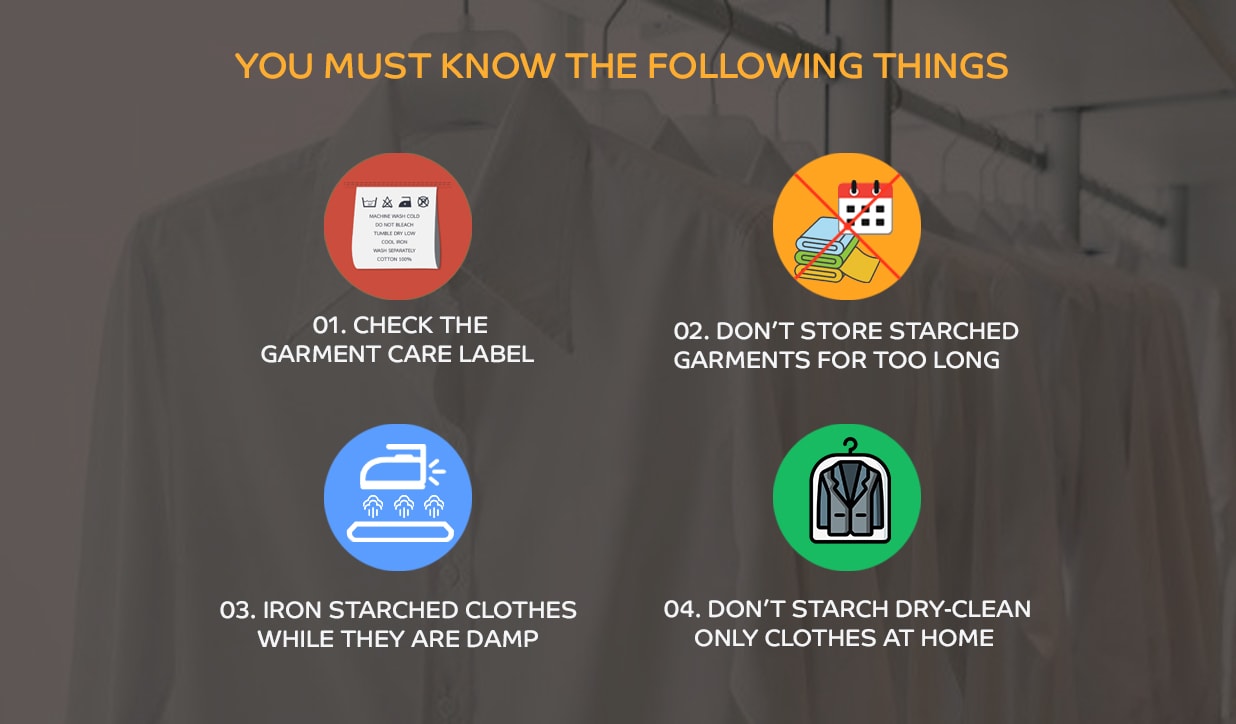
- If you will check the label of commercial starch for clothes you will see they have different levels: light, medium, or heavy. If you’re using heavier starch, you must soak and wash the item before reapplying starch.
- If you’ve starched an item, don’t put it into storage or keep it in your wardrobe for a long time. Only starch items you’re going to wear. This is because starch can attract bugs. Always clean an item thoroughly to remove starch before storing it.
- If using liquid starch, mix two cups with three gallons of water. Dip the item into the solution and hang to dry. Then iron while it’s still slightly damp.
- If the label says dry cleaning only, this includes starching the item. Always take it to a dry cleaner and ask them to do it for you.
In A Nutshell
Your cottons and linens need starching to stay crisp and fresh. Starch also helps in preventing wrinkles and giving a polished look to your outfit. Thus, it is good to know how to use starch for clothes. You can either use a store-bought starch as per the instruction label or as explained above. Apart from this you can prepare starch at home as well. You can either use cornstarch with water or add vinegar to the mixture.
Though it is good to use starch for clothes, still overusing may damage the fabric. You can simply follow the precise guidelines explained in the article and take good care of your clothes.
FAQs on using starch for clothes
You can either purchase starch or make it at home. Laundry starch is made from wheat, corn or rice. Even the homemade starch for clothes is perfect to use. However, you should make it properly.
No, you cannot use rubbing alcohol. It is effective to use vodka as it starch from potatoes work well (vodka is made from potatoes). If you want to give this a try, mix 1/3 cup of vodka to 2/3 cup of water. Fill this liquid in a spray bottle and use as a normal starch.
You may already know the benefits behind using starch for clothes. However, you should also know that heavy starch can decrease the tensile strength of fabrics and increase its rigidity. This will eventually damage the clothes. It generally happens when the starch residue settles into the clothes and cause the fabric threads to break and fray. Hence, it is suggested to use light or medium starch for clothes unless heavy starch is necessary.
After spraying starch on a garment, make sure you let it soak for 10-15 seconds before ironing. This way you there starch residue will not build-up on the bottom of your iron. Also, it is better to iron clothes when they are slightly damp.




